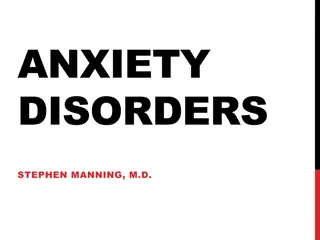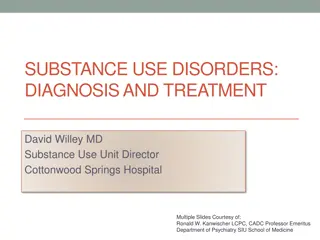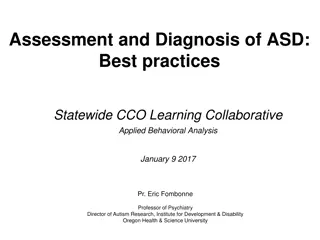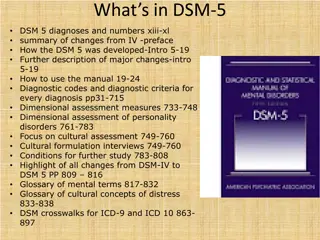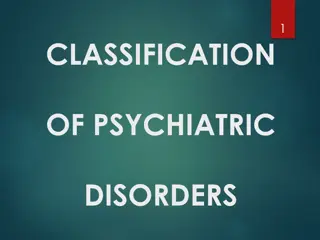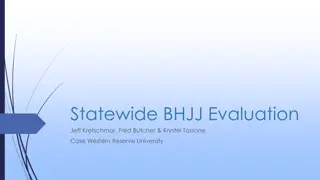Understanding the Relationship Between Mental Health and Diabetes: Insights for Educators
Exploring the link between mental health issues and diabetes, this presentation by Dr. Mary de Groot discusses the implications for diabetes educators. It delves into the prevalence of mental health conditions in people with diabetes, screening, treatment options, and interrelationships between diab
5 views • 45 slides
Embracing New Technologies and Best Practices in Operations by K. Premkumar
K. Premkumar, Manager of Operations, shares insights on adopting new technologies and best practices in the digital era. With a background in thermal power plants and a focus on innovation and sustainability, he highlights the importance of staying ahead in the industry. Topics covered include manua
5 views • 17 slides
Autism - What is it and how can you support an autistic person?
Autism Spectrum Disorder (ASD) is assessed using DSM-5 criteria, focusing on impairments in emotional reciprocity, relationships, and communication. Individuals may also display difficulties in movements, routines, interests, and sensory needs. Beyond ASD, considerations include ADHD, anxiety disord
3 views • 24 slides
Understanding Anxiety Disorders in DSM-5
Anxiety disorders encompass a range of conditions, from separation anxiety to social phobia and generalized anxiety disorder. The DSM-5 has re-conceptualized these disorders, grouping OCD in its own category and moving PTSD to trauma-related disorders. Recognizing symptoms and seeking appropriate tr
1 views • 96 slides
Understanding ADHD Diagnosis and Evaluation in Children and Adolescents
This resource provides valuable insights into the diagnosis and evaluation of ADHD in children and adolescents. It covers important diagnostic aspects, criteria from DSM-5 for inattention and hyperactivity-impulsivity, and outlines when to make a referral for a formal evaluation. The content sheds l
1 views • 18 slides
Understanding Gambling Disorders: Risks, Criteria, and Statistics
This content delves into the complexities of gambling disorders, covering a range of behaviors, diagnostic criteria according to DSM-5, prevalence statistics in the U.S., and the growing global gambling industry. It highlights the spectrum of gambling behaviors, criteria for diagnosing gambling diso
2 views • 21 slides
Understanding Anxiety Disorders: A Comprehensive Guide
Anxiety disorders are common mental health issues characterized by fear, anticipation of future threats, and avoidance behaviors. This overview covers the differences between stress and anxiety, types of anxiety disorders according to DSM-5, prevalence rates, impact on individuals, and the specific
0 views • 52 slides
Understanding Psychopathology and Diagnostic Systems in Mental Health
Psychopathology encompasses the study of mental illness and distress, with psychiatrists and clinical psychologists deeply involved in diagnosis and treatment. Signs of psychopathology can include mood changes, excessive worry, and withdrawal from activities. Diagnostic systems like DSM-5, ICD-11, a
0 views • 22 slides
Developmental Disability Eligibility Reform Amendment Act of 2022 Overview
The Developmental Disability Eligibility Reform Amendment Act of 2022 introduces new definitions, eligibility criteria, and expands services for individuals with developmental disabilities. It defines intellectual disability, developmental disability, and introduces substantial functional limitation
3 views • 13 slides
Understanding Gambling Disorder: Screening and Diagnostic Assessment
Dr. Kirk Christie, a Consultant Psychiatrist, delves into the world of gambling disorder, exploring definitions, neurobiology of addiction, screening instruments, DSM-V criteria, and harmful alcohol usage. Discover the differences between nondisordered, social, and problematic gambling behaviors, al
0 views • 27 slides
Updates in ADHD: Diagnostic and Medical Considerations for School Nurses
Review clinical features, diagnostic criteria, and treatment options for Attention Deficit Hyperactivity Disorder (ADHD) presented by experts during a School Nurses Conference. Covering DSM-V criteria, prevalence of subtypes, assessment of inattentive and hyperactive symptoms, and medication managem
5 views • 37 slides
Evolution of Addiction Concepts: Diagnosis and Treatment
Explore the changes in addiction concepts, DSM-V criteria, diagnostic criteria for substance use disorders, etiology, epidemiology, and treatment options including settings, pharmacotherapy, and therapeutic interventions as presented in a lecture by Dr. David Willey, MD, Substance Use Unit Director
0 views • 43 slides
HelmholtzCloud Service Selection Process Overview
The Helmholtz Cloud Service Selection Process is detailed through service surveys, iterations, criteria types, and exclusion processes. Service providers deliver data, weighting and selection criteria are applied, and candidate services are listed based on surveys and integrations. Criteria categori
0 views • 41 slides
Understanding Eating Disorders in Children by Dr. Soumi Kundu
Eating disorders in children, such as anorexia nervosa, bulimia nervosa, and binge eating disorder, are complex biopsychosocial disorders characterized by dysfunctional patterns of cognition and weight control behaviors. They result in significant physical, psychological, and social complications. T
0 views • 34 slides
Understanding Eating Disorders: Medical Complications and Treatment
This presentation by Dr. Maria C. Monge covers the common eating disorders in teenage patients, potential medical complications, and the role of the medical team in treatment. It includes definitions of disorders like Anorexia Nervosa, Bulimia Nervosa, and Binge Eating Disorder according to DSM-5 cr
0 views • 60 slides
Understanding ADHD in Scouts: Tips for Leaders
This presentation highlights Attention-Deficit/Hyperactivity Disorder (ADHD) in scouting, focusing on the DSM-5 criteria, characteristics of ADHD, and tips for leaders to support scouts with ADHD. It emphasizes strengths, challenges, medication management, and successful strategies for working with
0 views • 20 slides
Tunisia's Export Opportunities Focus: Africa and EU Presentation
Prof. Wilma Viviers and Prof. Leila Baghdadi from North-West University and University of Tunis present on Tunisia's export opportunities with a focus on Africa and the EU. The presentation outlines the TRADE-DSM methodology, identifying untapped export potential and key outcomes globally. The resea
0 views • 17 slides
Nutrient Criteria Development Plan for High Rock Lake Summary Update
Nutrient Criteria Development in North Carolina has evolved through various stages since 2001, with the key milestones being the development of the Nutrient Criteria Implementation Plan in 2004 and the Nutrient Criteria Development Plan in 2014. The plan aims to link nutrient concentrations with the
0 views • 8 slides
Understanding Autism Spectrum Disorder: Assessment, Diagnosis, and Characteristics
This content delves into the assessment and diagnosis of Autism Spectrum Disorder (ASD) with a focus on early markers, DSM-5 criteria, language/communication abnormalities, social interaction abnormalities, and repetitive behaviors/unusual interests. It provides a comprehensive overview of the key a
0 views • 20 slides
Understanding Human Comfort Requirements and Demand Flexibility in Smart Grids
Exploring the limitations set by human comfort requirements on Smart Grid Demand Response (DR), focusing on heat gains, heating and cooling systems, and demand flexibility. Discusses the impacts of comfort requirements on electrical demand, energy consumption in Finnish households, types of loads, a
0 views • 11 slides
Evolution from DSM-IV to DSM-5: Understanding Changes and Challenges
The transition from DSM-IV to DSM-5 was driven by the need to improve diagnostic accuracy, reflect shared symptomatology, integrate new research findings, and enhance cultural considerations. DSM-5 addressed shortcomings such as the multi-axial structure, unreliable measures like GAF, and the focus
0 views • 85 slides
Interdisciplinary Perspectives on End-of-Life Care
Exploring end-of-life care through an interdisciplinary lens, this presentation delves into social work, physical therapy, pharmaceutical aspects, and recommended interventions. Delicate considerations, diverse viewpoints, and evolving challenges in end-of-life decisions are examined, along with the
0 views • 52 slides
Understanding Dementia: Core Definition, Types, and Treatments
Chronic disorder affecting mental processes due to brain disease or injury, leading to memory problems, personality changes, and impaired reasoning. Explores types of dementia, differentiation from other conditions, and treatment options as well as cognitive domains specified by DSM-5.
0 views • 92 slides
Understanding Abnormal Psychology: Disorders, Symptoms, and Treatments
Explore the world of abnormal psychology through the lens of different disorders like depression, anxiety, and phobias. Learn about the definitions of abnormal behavior, DSM-V classifications, and various types of psychological disorders. Delve into the complexities of mental health conditions such
0 views • 39 slides
Understanding and Working with Transgender Individuals Who Sexually Harm
Explore the complexities of addressing sexual harm in transgender populations, learning objectives include understanding transgender experiences, treatment standards, and DSM-V diagnostic criteria for Gender Identity Disorder. Delve into issues like sexual harm, gender dysphoria, and personal biases
0 views • 53 slides
Tobacco Dependence Screening and Treatment in Behavioral Health Settings
This presentation focuses on building the capacity of prescribing clinicians in behavioral health settings to integrate best practices for prescribing tobacco cessation pharmacotherapy into standard care delivery. It includes goals, objectives, an agenda, and valuable information on tobacco dependen
0 views • 32 slides
Proposal to Update New Mexico Water Quality Standards: Copper Site-Specific Water Quality Criteria for the Pajarito Plateau
Develop a proposal for the New Mexico Water Quality Control Commission to adopt EPA's 2007 recommended copper ambient water quality criteria, focusing on the history of U.S. EPA aquatic life criteria for copper, the use of the BLM tool in aquatic toxicology, and the overview of proposed site-specifi
0 views • 10 slides
Psychological Assessment of Obese Children and Adolescents
Principles of psychological assessment in obese children and adolescents are discussed, including the Dietary Restraint Theory (DRT), Affect Regulation Theory (ART), Reinforcement Sensitivity Theory (RST), and Diathesis-Stress Model (DSM). These theories explore the cognitive, emotional, and environ
0 views • 5 slides
Overview of Classification of Psychiatric Disorders
Psychiatric disorders are illnesses with various manifestations that impact functioning due to disturbances in biological, social, genetic, and other factors. Two key classification systems, ICD-10 and DSM-5, categorize over 200 types of psychiatric illnesses. The ICD-10 includes categories like org
0 views • 18 slides
Understanding DSM-5: A Clinician's Perspective on Revisions and Changes
DSM-5, authored by Matt Dugan, LPC, and Steve Donaldson, MAC, CACII, provides a comprehensive look at the revisions and changes from DSM-IV-TR. It discusses the importance of evolving diagnostic systems to capture clinical experiences effectively. The book emphasizes the need for a dimensional appro
0 views • 46 slides
Understanding ADHD Subtypes and Diagnosis Criteria in DSM-IV-TR
ADHD, as defined in the DSM-IV-TR, encompasses three subtypes: Predominantly Inattentive Type, Predominantly Hyperactive-Impulsive Type, and Combined Type. To meet diagnostic criteria for each subtype, specific symptoms must be present for a certain duration and at a degree that is maladaptive. Indi
0 views • 23 slides
Understanding ADHD: Symptoms and Classroom Strategies
This comprehensive guide explores ADHD, its symptoms of inattention and hyperactivity/impulsivity, diagnostic criteria, and classroom strategies for children affected by ADHD. The seminar objectives include defining ADHD, identifying symptoms, evaluating classroom practices, and developing ADHD-awar
0 views • 19 slides
Statewide BHJJ Evaluation Demographics and Trends Analysis
This report presents an evaluation of the Statewide BHJJ Program conducted by Jeff Kretschmar, Fred Butcher, and Krystel Tossone from Case Western Reserve University. It includes insights into youth demographics, enrollment numbers by county, felony trends, youth and family history, OYAS assessment
0 views • 30 slides
Understanding Autism Spectrum Disorder in Chaplaincy Care
This presentation delves into the complexities of engaging with individuals on the autism spectrum within a chaplaincy setting. It covers the essentials of autism, patient and family experiences, practical pastoral care approaches, and case studies. The speaker, a chaplain and autism advocate, empha
0 views • 63 slides
Understanding Demand Side Management in West Bengal
Demand Side Management (DSM) involves modifying consumer electricity demand through methods like financial incentives and consumer education. In West Bengal, utility providers aim to reduce energy usage during peak hours to avoid costly capacity additions. The need for DSM arises from increasing ene
0 views • 14 slides
The Evolving Landscape of Digital Soil Mapping: Balancing Innovation and Stability
The continual evolution of Digital Soil Mapping (DSM) has introduced a paradigm known as "chasing the new horizon," emphasizing innovation and exploration. However, challenges such as lack of adherence to standards, covariate limitations, and concerns about the role of soil scientists in the face of
0 views • 4 slides
Analyzing and Enhancing Conversational Skills in Children with Autism
This content provides an in-depth analysis of teaching conversational skills to children with autism, focusing on the challenges defined in the DSM-5 criteria and practical interventions. It explores the definition of conversation, failure indicators, and behavioral analysis insights into verbal int
0 views • 20 slides
Understanding Pathological Gambling: Diagnosis and Epidemiology
Pathological gambling, characterized by the inability to resist the urge to gamble despite severe consequences, is a progressively worsening disorder. This text discusses the diagnostic criteria for pathological gambling, its positive diagnosis according to DSM-IV-TR, and epidemiological data on the
0 views • 23 slides
Overview of Psychiatric Pharmacology: A Comprehensive Guide from 2013
This presentation delves into the nuances of psychiatric pharmacology, exploring common psychiatric conditions, historical perspectives on medical treatments, categories of psychiatric medications, and principles of treatment. It also touches on mental illness definitions from DSM-IV-TR and DSM-V, a
0 views • 27 slides
Understanding Anxiety Disorders and Stress Management
Anxiety disorders, such as Generalized Anxiety Disorder and Panic Disorder, are common in medical settings and often coexist with various medical conditions. Patients with anxiety may also experience somatic symptoms like heart palpitations and sleep disturbances. The DSM-5 criteria for Generalized
0 views • 17 slides



